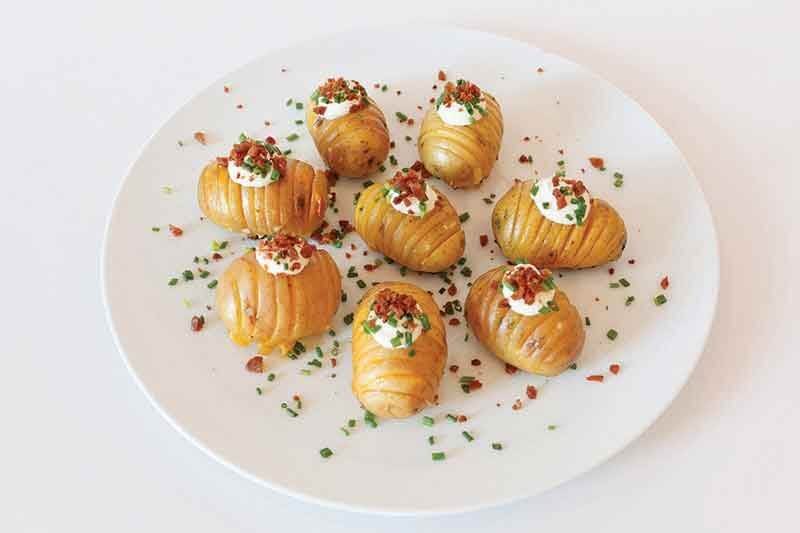Hasselback is having a moment, where chefs are rediscovering the potential of this classic technique. Thinly sliced across the width of the ingredient, then baked, Hasselbacks—most typically potatoes—deliver a unique experience of both crispy edges and soft interior that result in an addictive eating experience.
They also look impressive.
Inspired by today’s veg-centric movement that maximizes flavor and texture in produce, we’re seeing an emergence of Hasselback carrots, sweet potatoes, beets, apples, pears and, of course, potatoes—from fingerlings and babies to full-sized.
The thread that’s tying the trend together is a clever use of the little pockets made by the Hasselback technique, perhaps stuffed with bits of flavor-forward cheese or crispy pork, or drizzled with a bright vinaigrette or hot sauce.
- Pulled Short Rib with Hasselback rutabaga
— Redd, Yountville, Calif. - Hasselback fingerling potatoes with Comté cheese, bacon, tomato sauce
— Lait Cru Brasserie, based in Seattle - Gingerbread baba with rum-glazed Hasselback pear and butter pecan ice cream
— Headwaters, Portland, Ore. - Hasselback Apple with oatmeal streusel, cinnamon ice cream
— King + Duke, Atlanta
In the Groove
The Hasselback technique encourages a fun interpretation of today’s best flavor systems. For instance, a loaded baked potato can morph into a Hasselback shareable, with slices of a potato stuffed with bacon and cheese, then topped with sour cream and chives. Dipping sauces add interactivity, encouraging a dunk into a warm vinaigrette or spicy aïoli for any Hasselbacked root vegetable. Chefs are easily inspired by this flavor-building platform.
 Potatoes USA
Potatoes USA Mini potatoes offer a unique canvas for Hasselback technique—combining eye-catching presentation with flavor-catching grooves.
“We’re essentially deep-scoring the potato as thin and as far as we can without slicing all the way through, then poaching on low heat in white wine, butter and generous amounts of garlic. This creates a thinly sliced texture similar to that of a scalloped potato while maintaining the whole structure of the vegetable. This allows our poaching liquid to incorporate flavor more thoroughly into the potato than would be possible by poaching it whole, and provides a beautiful and unique presentation, as the individual slices fan out as they cook.”
Luis Cabanas, Chef de Cuisine, Paley’s Place, Portland, Ore.
“Hasselback is one of those techniques that can be used for almost anything—from root vegetables and fruits to even proteins. When it comes to super classic methods like this, I always try to find new ways to rework them. One of the coolest dishes that I have done with this method is actually with pineapple and foie gras. I poached baby pineapple in pineapple juice, miso and togarashi, then sliced it very thin and placed thin slices of foie gras torchon inside. It was quite beautiful and tasted amazing!”
Greg Biggers, Chef/Partner, Fort Louise, Nashville
“I’ve always enjoyed the texture that Hasselback technique offers to a dish. The added surface area that it creates is a huge benefit for seasoning and creating an extremely flavorful experience.”
Brian Enyart, Chef/Partner, Dos Urban Cantina, Chicago
“Hasselback is a great technique that can be applied to any root vegetable, as well as fennel, that takes well to roasting. Its great advantage is the ability to flavor the interior of the product with infused oils, chile pastes and dry rubs. But resist any high-humidity ingredients as they will interfere with a good roast. Rather, add them (elements like tapenades, pestos, fruit reductions, vegetable or fruit purées, yogurt-based sauces, etc.) at the end of the cooking process or even last minute.”
Chris Koetke, VP, Category Management, Culinary Arts, Laureate International
“I like this style a lot for the combination of textures and the great visuals on the plate, as well as how flavor adds will permeate all of the potato. Most starchy vegetables (some carrots, summer squashes, etc.) that can maintain their structural integrity after cooking could be enhanced by this method.”
Darryl Mickler, Senior Director of Global Research and Development, Hard Rock International










